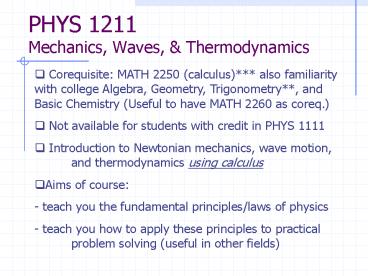PHYS 1211 Mechanics, Waves, - PowerPoint PPT Presentation
1 / 8
Title:
PHYS 1211 Mechanics, Waves,
Description:
Physics is Science. The Scientific Method was and is applied in the formulation of physics ... kinematics - forces - work/energy - waves - thermodynamics ... – PowerPoint PPT presentation
Number of Views:52
Avg rating:3.0/5.0
Title: PHYS 1211 Mechanics, Waves,
1
PHYS 1211 Mechanics, Waves, Thermodynamics
- Corequisite MATH 2250 (calculus) also
familiarity with college Algebra, Geometry,
Trigonometry, and Basic Chemistry (Useful to
have MATH 2260 as coreq.) - Not available for students with credit in PHYS
1111 - Introduction to Newtonian mechanics, wave
motion, and thermodynamics using calculus - Aims of course
- - teach you the fundamental principles/laws of
physics - - teach you how to apply these principles to
practical problem solving (useful in other
fields)
2
Physics is Science
The Scientific Method was and is applied in the
formulation of physics
What is the Scientific Method? (http//teacher.pas
.rochester.edu/phy_labs/appendixe/appendixe.html)
- Observation/description of natural phenomenon
- Formulate hypothesis to explain phenomenon
- Use hypothesis to predict other (related)
phenomena - Perform experiment/observation to test hypothesis
- Repeat (3) and (4) many times
- If step (5) is all correct, then the hypothesis
(2) may be regarded as a law or theory of nature - If (5) is incorrect, start over at (2)
3
A Building-Up of Principles
What is Physics?
Definition the science that deals with matter
and energy in terms of motion and
force Operational definition given some
experimental observa- tion, a theory is developed
to describe it. The theory is then used to make
predictions, which are then tested with further
experiments or observations.
Algebra -gt geometry -gt trigonometry-gt kinematics
-gt forces -gt work/energy -gt waves -gt
thermodynamics -gt -gt electricity/magnetism -gt
optics -gt
4
Some examples synchronized diving (Beijing 2008
Olympics)
5
Butterfly stroke (Beijing 2008 Olympics)
6
The Classification of Physics
Classical Physics - everyday speeds and sizes
(Newton, )
Relativistic Physics - Very fast (Einstein, )
Quantum Physics - very small (Dirac, )
Relativistic Quantum Physics very small and
very fast (Feynman, )
7
Chapter 1 The Basics
- Things you should already know or will need to
learn about - Units SI will be used (mostly), British units
will be used occasionally (foot, pound) - Significant figures (covered in lab)
- Dimensional analysis
- Order-of-magnitude estimates
8
Vectors and Scalars (more in Chap. 3)
- Physical Quantities
- Scalar a quantity that can be completely
specified by a single number or magnitude (and
units) e.g., temperature, mass, speed (70 mph),
energy, - Vector a quantity which has both a magnitude
and a direction (and units) e.g., force,
velocity, displacement,
N
v70 mph
Physical quantities have explicit definitions
?5?
E
v70 mph, 5? N of E






























